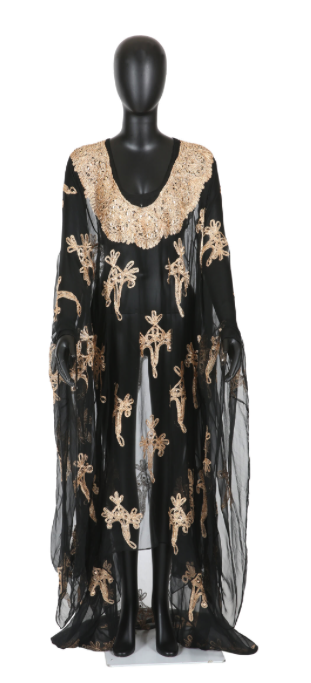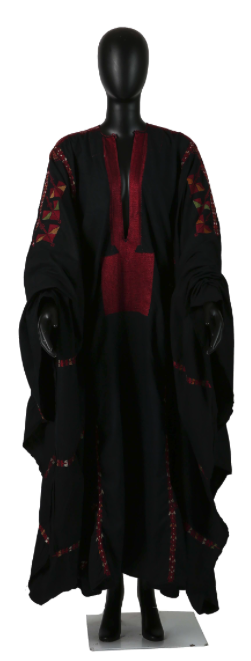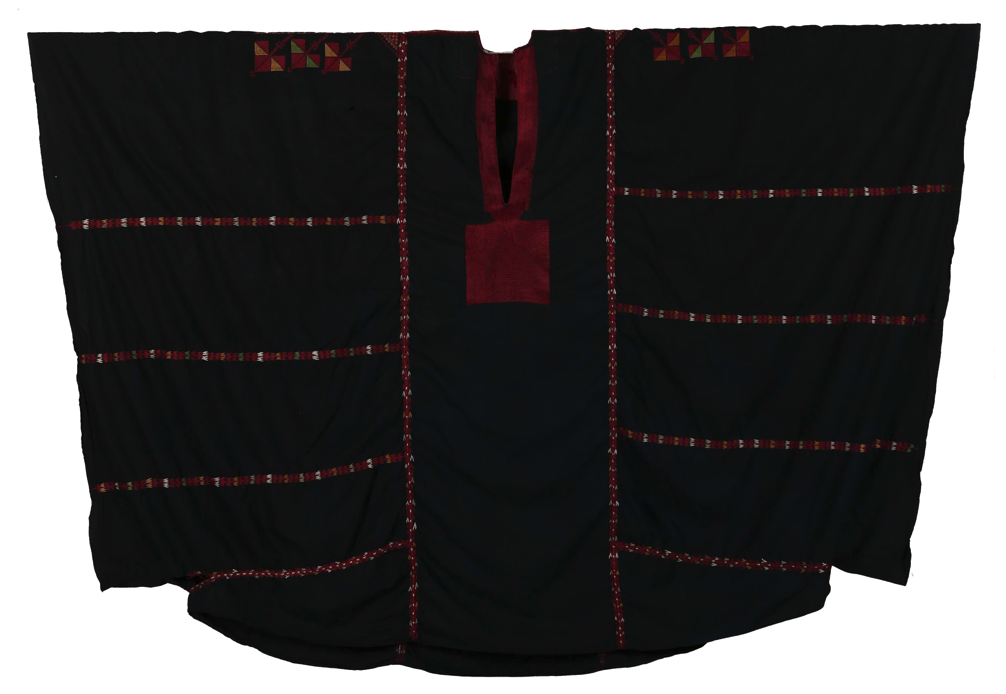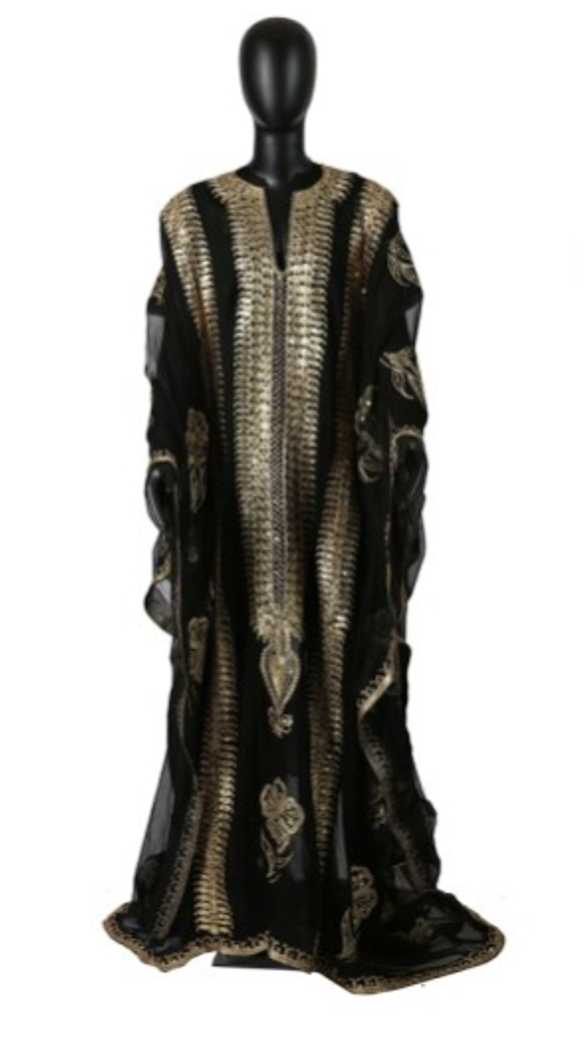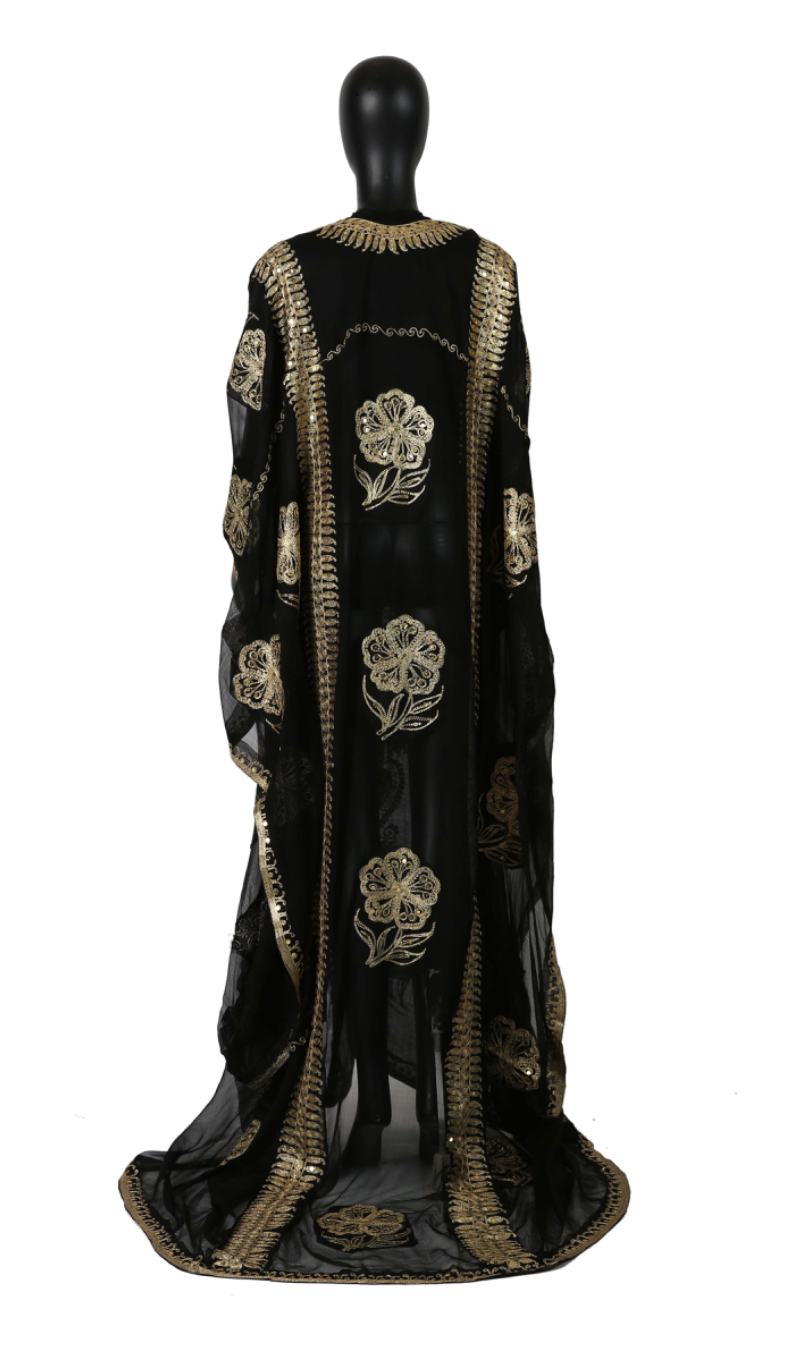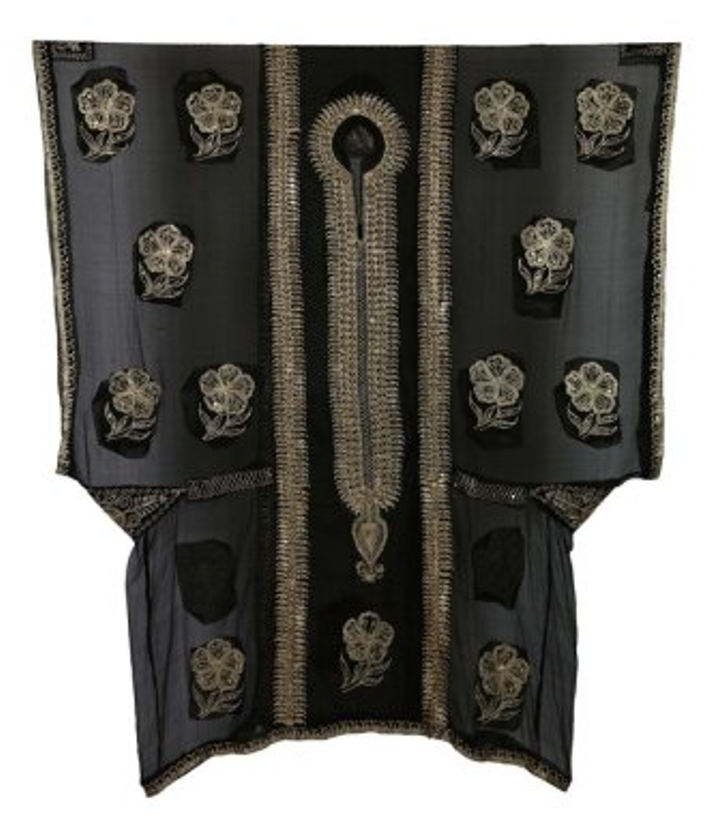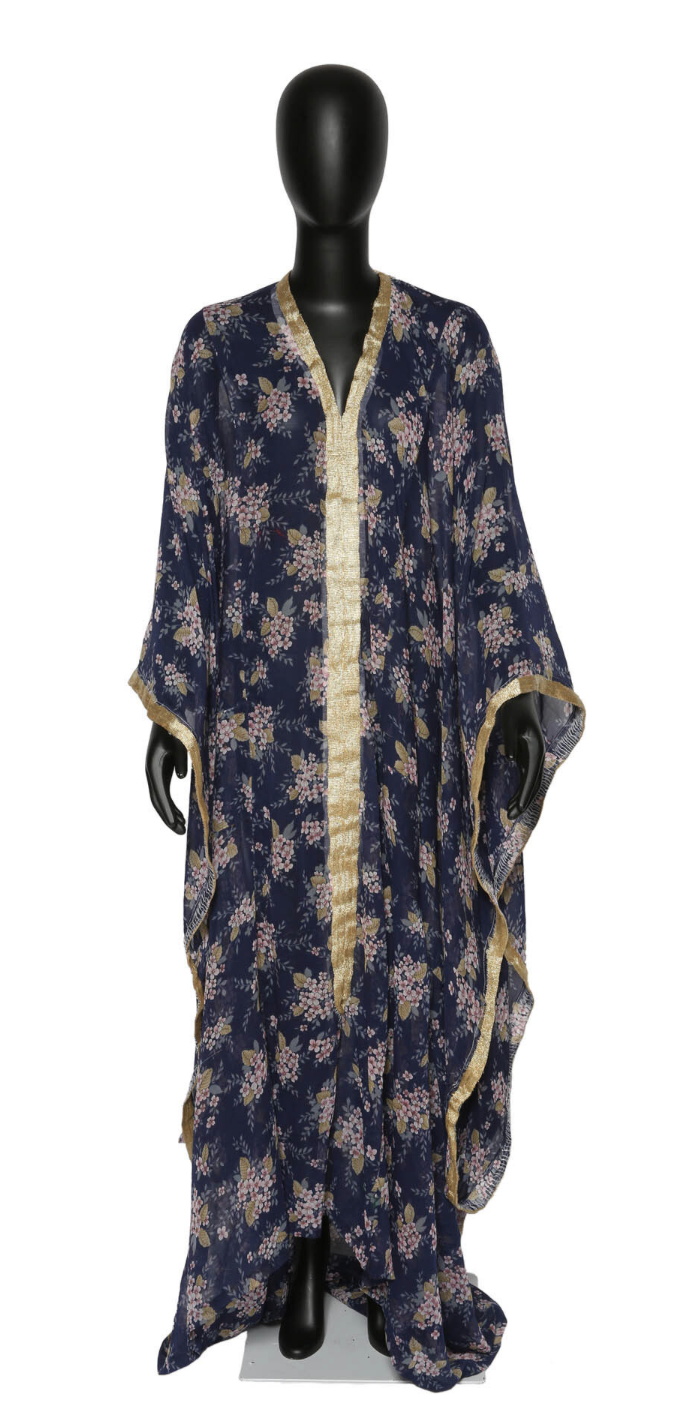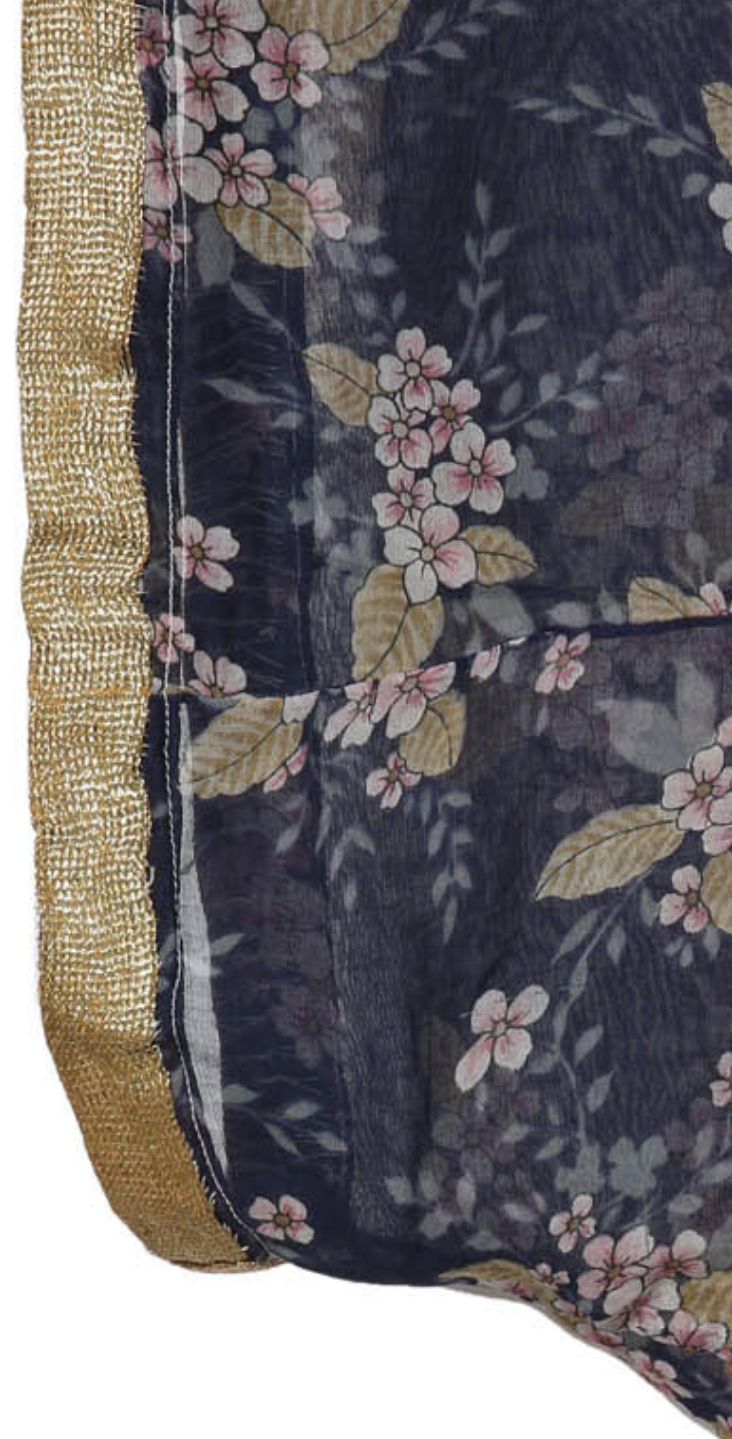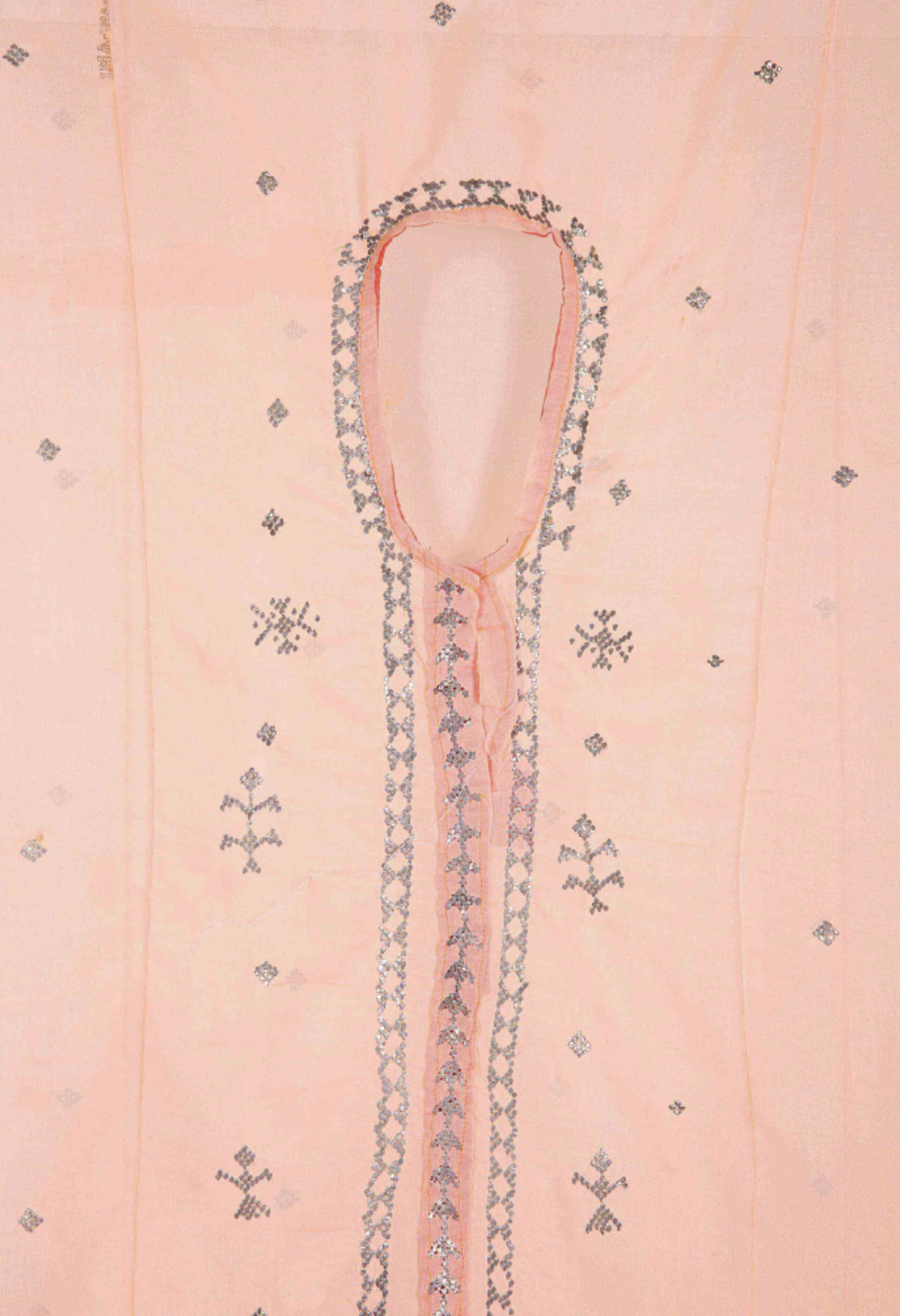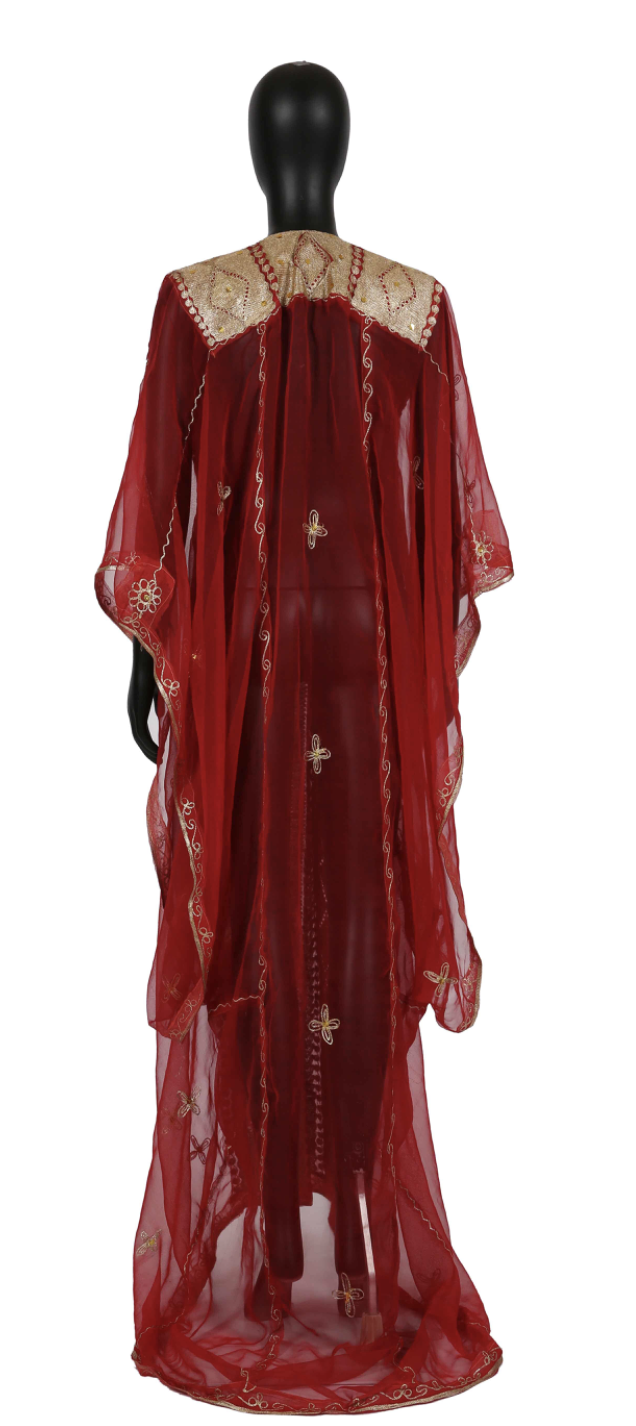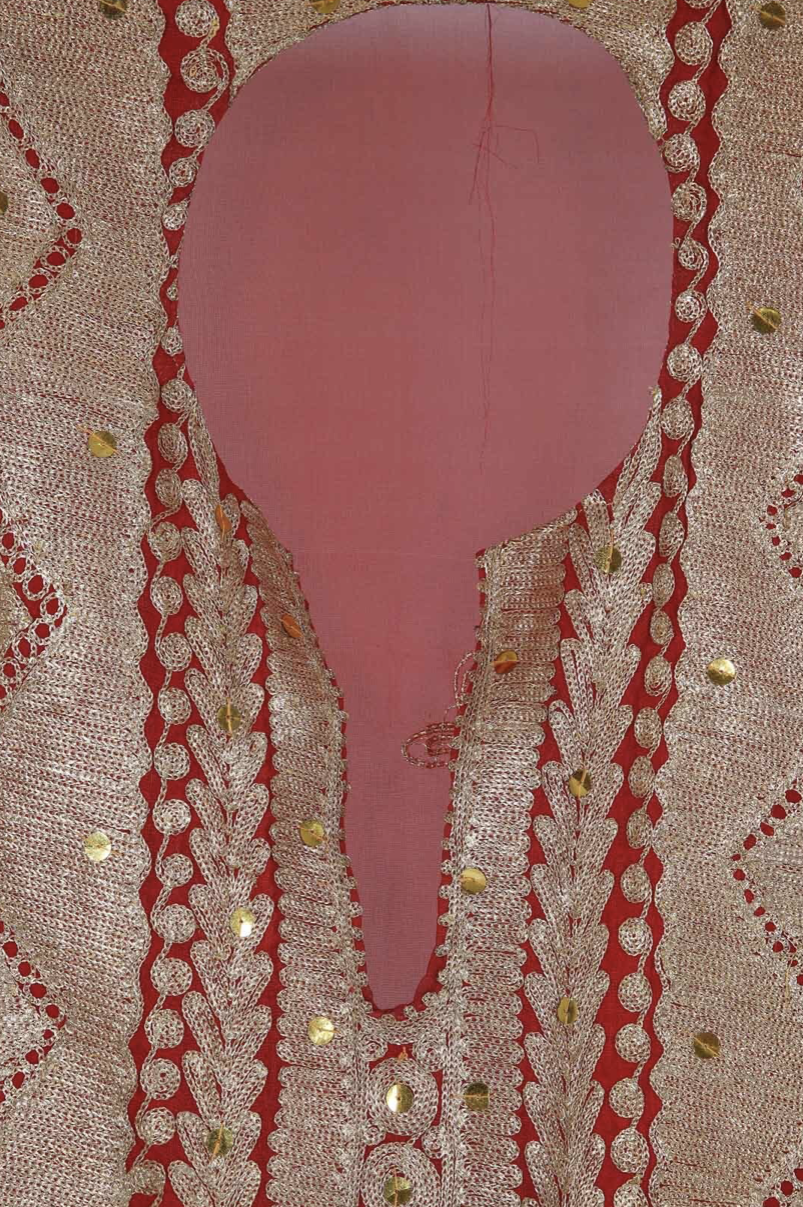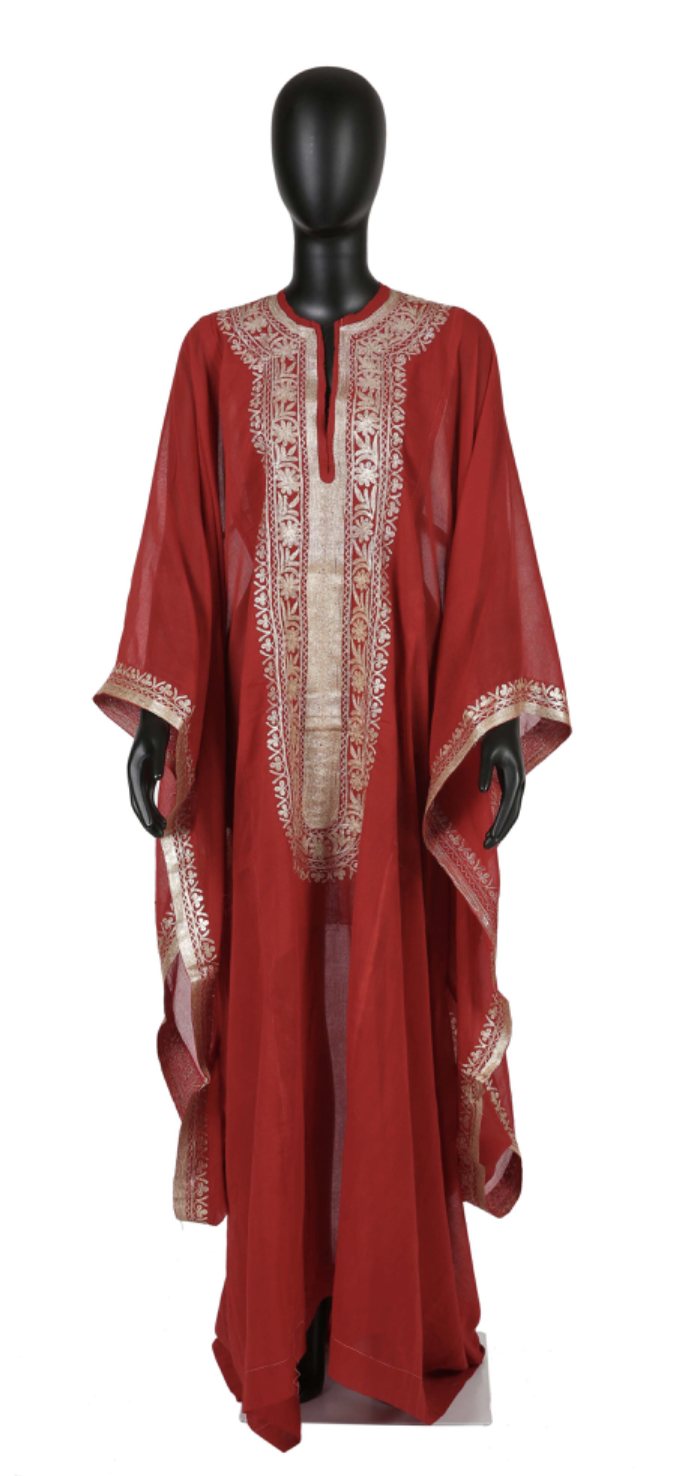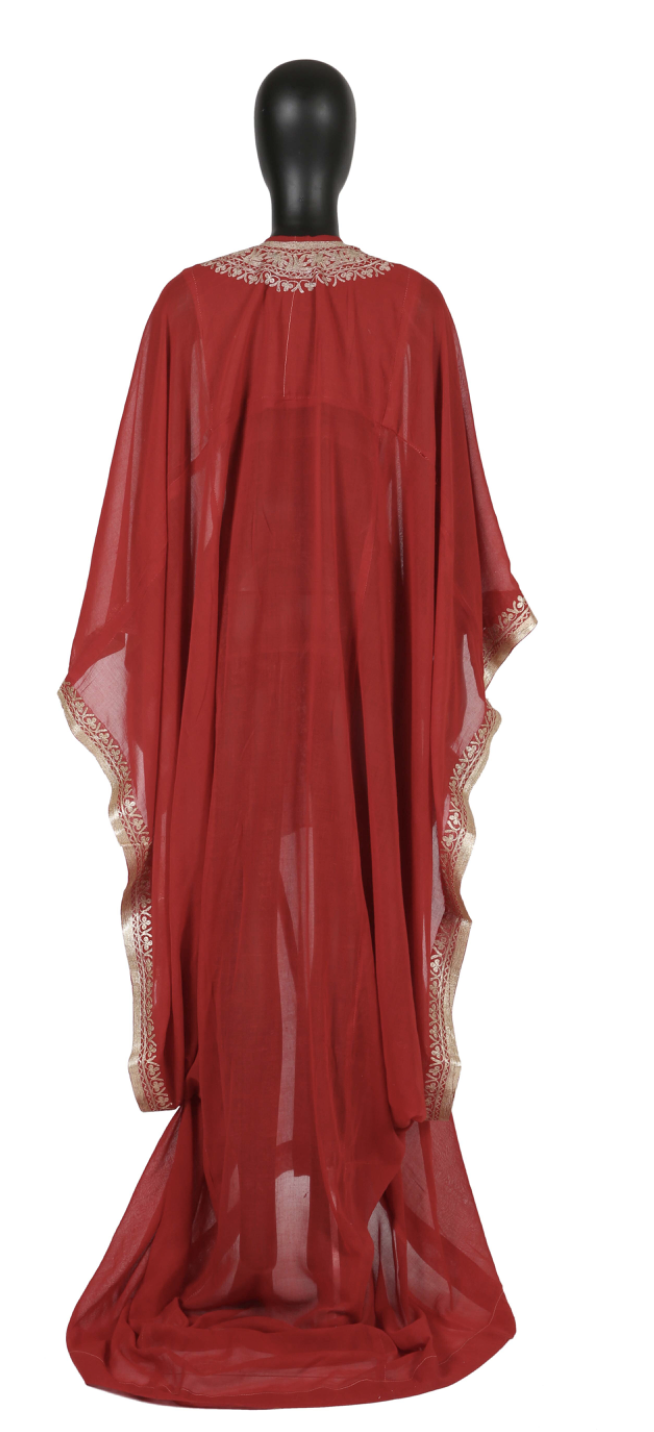The traditional garments of the Arab East – the countries of the Arabian Peninsula and south eastern Iraq – are a testament to the region’s rich and profound cultural heritage, embodying intricate craftsmanship and deep symbolic significance. Among these garments, women’s ceremonial robe style overgarments, or thiyāb or thībān (pl for thawb), hold a particularly esteemed place. This study explores various notable categories of women’s traditional robes, focusing on their distinctive features and legacy in cultural contexts.
Thawb Hashmi
We commence our examination with a garment that embodies regal elegance and derives its name from its noble associations: the Thawb Hashmi. An elaborately decorated traditional women’s garment originating from Iraq, the thawb hashmi is named after the royal Hashemite family of Najd, KSA.
The hashmi is traditionally worn in regions spanning from Baghdad in central Iraq to Basrah in the south, underscoring its cultural and geographical ties to the Arabian Peninsula. While some scholars have posited the existence of over forty distinct types of hashmi in Iraq, there is currently no extant material evidence to substantiate such claims. However, thawb hashmi from the past century can be clearly distinguished from their Gulf counterparts by a notable stylistic feature: the use of round necklines, which are otherwise absent in similar garments from the Gulf region.
Although examples of these round-neck thawb hashmi are rare today, their presence is documented in photographic records from the period. One such garment is preserved in The Zay Collection, providing tangible evidence of this stylistic variation.
Front of a thawb Hashmi; Embellished Silk Tunic Robe, Iraq, c. 20th century;
ACC No: ZI2021.500871.2 IRAQ, Donated by Omaima Marmarchi to The Zay Initiative Collection.
The decline in the use of round-neck hashmi appears to correlate with the economic expansion of the Gulf states, during which there was a marked increase in the acquisition and consumption of these garments from the Gulf countries across the region.
Furthermore, this period of cultural and commercial exchange appears to have influenced the traditional Bedouin thawb, which began to adopt certain stylistic elements from the Iraqi hashmi, such as round necklines and voluminous sleeves. This suggests a dynamic interplay between regional dress traditions, shaped by both socioeconomic developments and cross-cultural interactions.
Front of a thawb; Embellished Cotton Tunic, Iraq, c. 20th century;
ACC No: ZI2022.500989 IRAQ, The Zay Initiative Collection.
Historically sewn in cities such as Najaf, Hilla, and Basra, this robe was later embraced in the countries of the Arabian Peninsula, particularly for ceremonial occasions like weddings. Characterized by its ornate embroidery and large sleeves, the hashmi is often worn over a contrasting undergarment or gömlek and a jacket-style overgarment sayah, which enhances its intricate details. Although its exact origins are uncertain, the hashmi remained a prominent ceremonial dress in Iraq until the mid-20th century.
Traditionally associated with ceremonial occasions due to its intricate and refined embroidery, this garment is notable for its aesthetic similarities to the Thawb Najdi and Thawb Nashl. These resemblances have often led to it being mistaken for one of these other styles.
In Addition to its notably wider and more expansive sleeves that could be draped over head for a more modest look while covering the body of the wearer, the hashmi is also characterized by an elaborately embroidered central front panel that extends to the back of the garment, a design element that is not typically observed in the nashl or the najdi. This continuity of intricate decoration further enhances the regal and ceremonial aesthetic of the hashmi.
Front and back of a thawb hashmi; Embellished Silk Tunic Robe, Iraq, c. 20th century;
ACC No: ZI2022.500990.1 IRAQ, Gifted by Buthaina ____ to Dr Reem Tariq El Mutwalli; The Zay Initiative Collection.
Sample of wide sleeves of a thawb hashmi; Embellished Silk Tunic Robe, Iraq, c. 20th century;
ACC No: ZI2022.500990.1 IRAQ, Gifted by Buthaina ____ to Dr Reem Tariq El Mutwalli; The Zay Initiative Collection.
Thawb Kurar
The thawb kurar is a square-shaped robe adorned with woven bands of metal thread, known as kurar. This craft involves hand-twisting and weaving metal threads to create decorative ribbons. Popular amongst the women from the Arabian Peninsula especially Kuwait Bahrian and Qatar, this decorative technique is integral to the region’s sartorial identity. the thawb kurar showcases the artistry and skill involved in the traditional craft of passementerie.
The term kurar originates from Arabic and denotes handwoven bands or ribbons composed of twisted metal threads and cords, closely resembling passementerie. These intricately crafted bands are often sewn together in varying widths and applied to garments as decorative elements. The term kurar encompasses both the artisanal craft itself and the final decorative product.
The craft of kurar necessitates the collaborative expertise of skilled artisans, typically involving a group of two or three women referred to as dawakhil, under the guidance of a master craftswoman known as the qattabah. During the intricate process, the artisans sit opposite the qattabah, each taking turns to skilfully organize the threads on her fingers, passing them between hands to interlace the strands. This meticulous coordination results in the creation of a flat, woven ribbon or band, also termed kurar, which is subsequently sewn directly onto garments. These decorative bands, often applied along borders and edges, significantly enhance the garment’s aesthetic and cultural value.
A sample of a thawb kurar; Metal Embellished Printed Cotton Tunic Robe, Muharraq, Bahrain, c. 1990;
ACC No: ZI2018.500381.2 BAHRAIN, The Zay Initiative Collection.
A sample of a kurar band adorning the edge of the sleeves of a thawb; Metal Embellished Printed Cotton Tunic Robe, Muharraq, Bahrain, c. 1990; ACC No: ZI2018.500381.2 BAHRAIN, The Zay Initiative Collection.
Thawb Naqdah (or Thawb Naghdah)
The thawb naqdah is characterized by its hammered metal plate embellishments, forming patterns that highlight its ceremonial significance. Widely favoured in the Arabian Peninsula as a popular choice for a distinctive and elegant festive attire, due to its intricate and shimmering metal embellished designs.
The craft of naqdah is closely associated with other traditional embroidery techniques across various cultures, such as the Indian bādla, the Persian khus dozi, and the Egyptian tulle bi talli. These crafts share a common characteristic of employing metal threads or hammered embellishments to create intricate decorative patterns, reflecting a rich heritage of textile artistry in their respective regions.
Closeup of embellishment of a thawb naqdah; Metal Embellished Cotton Tunic Robe, Muharraq, Bahrain, c. 1990; ACC No: ZI2021.500879.1 BAHRAIN, The Zay Initiative Collection.
Thawb Nashl
The thawb nashl, distinguished by its elaborate central embroidery, holds a significant place in the bridal traditions of the Arabian Peninsula. This garment traces its roots to Bahrain, where its production began in the 1940s. Initially, materials such as silk chiffon and gilded metal threads were imported from Gujarat, India, before being embroidered locally. Over time, finer fabrics from Europe became prevalent. The name nashl is thought to derive from mnshal, referring to the vibrant fabrics used for ceremonial purposes, or alnashl, meaning “pickpocket,” metaphorically capturing its captivating beauty.
Notable for its elaborate central embroidery, often using gilded metal threads the embroidery is hammered and polished to a smooth finish, signifying both tradition and innovation. Prior to its local production, the garment was imported from India to meet demand.
Once Bahrainis began crafting the thawb nashl, merchants sourced its distinctive fabric, made from natural chiffon silk, from India. The sewing and intricate embroidery of the dress, using zari—metal threads typically imported from Gujarat, India—were performed locally. Occasionally, higher-quality materials, such as zari and fabrics, were also imported from European countries like Germany and France.
The dress is crafted in a T-shape, with the fabric cut into longitudinal and cross-sectional pieces. Its neck opening can be circular, triangular, or square, featuring a front slit that extends to the middle or lower chest. This slit is often decorated with zari ball buttons and loops for closure, emphasizing the garment’s elegance.
Muhammad Saleh Ahmad Zari is renowned as one of Bahrain’s most accomplished thawb nashl artisans of the 20th century. His meticulous craftsmanship involved hand-embroidering the garment with zari threads and then hammering and burnishing the embroidery to achieve a polished, smooth, and lustrous finish.
Over time, the production of the thawb nashl transitioned to mechanized sewing and embroidery, incorporating a broader range of fabrics, including both natural and synthetic chiffon silk, in various colours. This evolution has allowed the garment to retain its cultural significance while adapting to contemporary manufacturing methods.
Front and back of a thawb nashl; Metal Embellished Silk Tunic Robe, Bahrain, c. 1983; ACC No: ZI2018.500703.2 BAHRAIN, The Zay Initiative Collection.
Closeup of the embellishment on a thawb nashl; Metal Embellished Silk Tunic Robe, Bahrain, c. 1983; ACC No: ZI2018.500703.2 BAHRAIN, The Zay Initiative Collection.
The thawb nashl can be categorized into two distinct variants: the thawb nashl zari fadhah and the thawb nashl kurar. Each variant is characterized by its unique decorative techniques and materials, reflecting diverse regional traditions and aesthetic preferences within the Arabian Peninsula.
- Thawb Nashl Zari Fadhah: A variation of the thawb nashl, this garment features gilded metal often silver thread embroidery along its front central axis, enhancing its luxurious appeal and distinguishing it from other types.
Front and back of a thawb nashl zari fadhah; Metal Embellished Silk Tunic Robe, Muharraq, Bahrain, c. 1970; ACC No: ZI2018.500224.2 BAHRAIN, The Zay Initiative Collection.
- Thawb Nashl Kurar: This variant incorporates the kurar bands also in silver or gilded silver, this version blends the nashl’s intricate patterns with the handwoven metallic ribbons or bands.
In conclusion, this initial segment has explored key examples of women’s ceremonial robes from Iraq and the Arabian Peninsula—highlighting garments such as the thawb hashmi, thawb kurar, thawb naqdah, and thawb nashl—each deeply rooted in historical craftsmanship and rich cultural symbolism. These garments not only exemplify the region’s diverse textile heritage but also underscore the role of clothing as a medium for social identity, artistic expression, and interregional exchange. The subsequent instalment of this study will further examine other noteworthy thiyāb from the broader Arab East, delving into their distinguishing characteristics and continued relevance in both cultural and social contexts.
